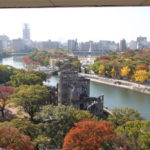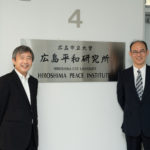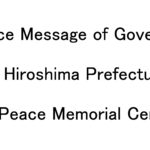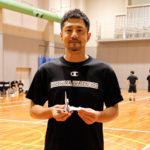I The Process of Establishing the Hiroshima Peace Memorial City Construction Law and Its Content
The initial reconstruction plan was determined in the period from October to November 1946, and land readjustment was to be implemented to proceed with the plan. Land readjustment projects, however, were extremely difficult not only in Hiroshima but also in other war-damaged cities across the country. On June 24, 1949, the Basic Policy on Reviewing War-damaged City Reconstruction Plans was approved by the Cabinet. This review advised reducing the areas for land readjustment and downsizing the widths of the planned roads, saying, “Appropriately change the width of roads which are unduly wide (about 30 meters or wider), taking into account the feasibility and urgency.” This was a significant reversal from the original policy.
Based on this policy, the reconstruction plans were reviewed and scaled down across the country. The number of 100-meter wide roads, for example, was drastically reduced from 24 to four in the country (Table 4-1, 4-2). In addition to reducing the number of 100-meter roads, the overall area of land readjustment was greatly reduced. Initially, land readjustment was planned for a total area of approximately 180 million tsubo (595 million square meters), but the reviewed five-year plan in later day reduced this area to almost half, to approximately 85 million tsubo (281 million square meters) as of 1960.
Among the financial difficulties of the war-ravaged cities across the country, the hardship of the A-bombed city of Hiroshima was most extreme. The burden of the emergency projects and measures needed was enormous while the tax revenue was minuscule. Under such conditions, those who were in charge of reconstruction were not idle. In order to cope with these conditions, they made strenuous efforts to find a way, and finally came up with the idea of enacting a “Hiroshima Peace Memorial City Construction Law.”
Table 4-1 Number of 100-meter roads in reconstruction plans
| City | 100 meters | 80 meters |
| Tokyo | 13 | 1 |
| Yokohama | 2 | |
| Kawasaki | 2 | |
| Nagoya | 2 | |
| Osaka | 4 | 1 |
| Kobe | 1 | |
| Hiroshima | 1 | |
| Total | 24 | 3 |
(Survey on the special city planning projects according to road width, conducted by Civil Engineering Division, Planning Bureau, War Damage Reconstruction Agency, on November 12, 1947)
Table 4-2 Number of 100-meter roads in reconstruction plans
| City | 100 meters or wider | 100 meters or wider |
|
Before Review |
After Review | |
| Tokyo | 7 | 0 |
| Yokohama | 2 | 1 |
| Kawasaki | 1 | 0 |
| Nagoya | 2 | 2 |
| Osaka | 2 | 0 |
| Hiroshima | 1 | 1 |
| Total | 16 | 4 |
(Comparison of road plans in war-damage reconstruction projects, before and after review, by City Bureau, Ministry of Construction, June 28, 1949)
From soon after the war ended, they repeatedly requested the national government to consider special subsidies and transfer of national government properties to Hiroshima. For instance, as early as November 13, 1945 the Hiroshima City Council submitted “Opinions on the Reconstruction of Hiroshima” to General Douglas MacArthur at GHQ requesting special high-rate assistance for the reconstruction projects in Hiroshima. In January of 1946, Mayor Shichiro Kihara requested the national government to transfer the former military land to Hiroshima. He made this request many times after that as well.
The period from the end of the war to about November 1948 can be called “Phase 1” of the reconstruction. It was when people lobbied for special subsidies and for transfer of government properties to Hiroshima. Phase 2 starts from November 30, 1948, when the Hiroshima City Council adopted a petition to request the national government to conduct the reconstruction and building of Hiroshima as a national project. This period can be called the “national reconstruction project petition period.”
On February 13, 1949, city officials and city council members met those who had ties to Hiroshima and the chairmen of committees of the House of Councillors and lodged the petition. Things began to develop rapidly when Nobuo Asaoka, a member of the House of Councillors, and Tsukasa Nitoguri, Chairman of the Hiroshima City Council, visited the office of Tadashi Teramitsu, Director General of the Proceedings Department of the House of Councillors. Teramitsu presented the idea of using the framework of a special law stipulated in Article 95 of the new constitution, and they decided to quickly write a draft. Phase 3 of the reconstruction started then. This law was to be called the “Hiroshima Peace Memorial City Construction Law” (sometimes abbreviated to Peace City Law), so Phase 3 can be called the “Peace City Law movement period.” The keyword “Peace Memorial City” came to be used then. The proposed Peace City Law said in Article 1, “It shall be the object of the present law to provide for the construction of the city of Hiroshima as a peace memorial city to symbolize the human ideal of sincere pursuit of genuine and lasting peace.” Here the law clarified the objective of the city construction and called for people’s efforts to pursue it. Furthermore, Article 6, Responsibility of the Mayor of Hiroshima, says, “The mayor of Hiroshima shall, with the cooperation of residents and support from relevant organizations, establish a program of continuous activity toward completion of the Hiroshima Peace Memorial City.”
The Hiroshima Peace Memorial City Construction Law unanimously passed the Lower House on May 10, 1949, and the Upper House on May 11. Therefore Phase 3, the Peace City Law movement period, is until the law passed the Diet on May 11, 1949.
Subsequently, on May 14 of that same year, the Speaker of the House of Representatives, in accordance with the Local Autonomy Act, officially informed the Prime Minister of the fact that the Hiroshima Peace Memorial City Construction Law was a special law under Article 95 of the Constitution. On July 7 of that year, the law was supported by the local referendum, and it was promulgated on August 6. This period can be called Phase 4 of the reconstruction, until the enactment of the law, with which the movement calling for the Hiroshima Peace Memorial City Construction Law ended. Voter turnout of the local referendum held in the city of Hiroshima was 65.0 %, of which 91.0% supported the law. This means 59.2% of the eligible voters voted for the law at the referendum. In this way, the Hiroshima Peace Memorial City Construction Law, a special law for Hiroshima, was established and promulgated on August 6, 1949. Phase 5 was the period that followed, when the Peace City Law was implemented and used. It played a major role in the reconstruction process in Hiroshima.
Notes and References
Tags associated with this article








